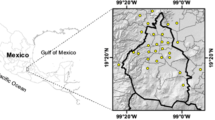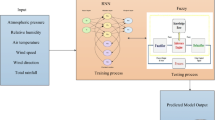Abstract
The main purpose of this study is to propose a decision support system that deals with the uncertainties in a model of atmospheric dispersion and in meteorological data (speed and direction of wind), which may negatively affect the model accuracy. This later helps the safety agencies in making decisions and allocating necessary materials and human resources to handle potential disastrous events. In order to investigate the aforementioned issues and provide a more reliable data we propose the adaptive Neuro-Fuzzy inference (ANFIS) system enhanced by the mean particle swarm optimization (PSO) to predict the concentration of Sulfur Dioxide release in the atmosphere. This method takes the advantages of fuzzy logic system to address the uncertainties and the ability of neural network to learn from the data. Furthermore our study attempts to estimate the severity index of the released material with the help of fuzzy logic. The result of our study shows that the presented method is successfully applied and it can be a powerful alternative to deal with Sulfur Dioxide release.











Similar content being viewed by others
Abbreviations
- AGEL :
-
Acute exposure guideline levels
- Hazmat :
-
Hazardous material.
- ANFIS :
-
Adaptive Neuro-Fuzzy Inference System.
- FLS :
-
Fuzzy logic system.
- FIS :
-
Fuzzy inference system
References
Abdo H, Flaus JM, Masse F (2017) Uncertainty quantification in risk assessment-representation, propagation and treatment approaches: application to atmospheric dispersion modeling. J Loss Prev Process Ind 49:551–571
Aswin KR, Renjith VR, Akshay KR (2022) FMECA using fuzzy logic and grey theory: a comparitve case study applied to ammonia storage facility. Int J Syst Assur Eng and Manag 13(4):2084–2103
Barad ML (1958) Project Prairie Grass, a field program in diffusion, vol 1. Air Force Cambridge Research Labs Hanscom Afb MA
Baranidharan B, Santhi B (2016) DUCF: distributed load balancing unequal clustering in wireless sensor networks using fuzzy approach. Appl Soft Comput 40:495–506
Basheer A, Tauseef SM, Abbasi T, Abbasi SA (2019) A template for quantitative risk assessment of facilities storing hazardous chemicals. Int J Syst Assur Eng Manag 10(5):1158–1172
Beasley D, Bull DR, Martin RR (1993) A sequential niche technique for multimodal function optimization. Evol Comput 1(2):101–125
Brits R, Engelbrecht AP, van den Bergh F (2007) Locating multiple optima using particle swarm optimization. Appl Math Comput 189(2):1859–1883
Camastra F, Ciaramella A, Giovannelli V, Lener M, Rastelli V, Staiano A et al (2015) A fuzzy decision system for genetically modified plant environmental risk assessment using Mamdani inference. Expert Syst Appl 42(3):1710–1716
Chang JC, Hanna SR (2004) Air quality model performance evaluation. Meteorol Atmos Phys 87(1):167–196
Gheorghe AV, Birchmeier J (2002) Hot spot based risk assessment for transportation dangerous goods by railway: a new proposal for transportation risk assessment. ETH Zurich.
Gheorghe A, Gheorghe AV, Vamanu D (1996). Emergency planning knowledge (No. 13). vdf Hochschulverlag AG
Gheorghe AV, Grote G, Kogelschatz D, Fenner K, Harder A, Moresi E (2000) Integrated risk assessment, transportation of dangerous goods: case study.Target: Basel-Zurich/VCL. ETH KOVERS, Zurich
Guo S, Yang R, Zhang H, Weng W, Fan W (2009) Source identification for unsteady atmospheric dispersion of hazardous materials using Markov Chain Monte Carlo method. Int J Heat Mass Transf 52(17–18):3955–3962
Haupt SE, Young GS, Allen CT (2007) A genetic algorithm method to assimilate sensor data for a toxic contaminant release. J Comput 2(6):85–93
Hiemstra PH, Karssenberg D, Van Dijk A, De Jong SM (2012) Using the particle filter for nuclear decision support. Environ Model Softw 37:78–89
Hofman R, Šmídl V, Pecha P (2014) Development of real-time Bayesian data assimilation system for off-site consequence assessment. Prog Nucl Sci Technol 4:771–774
Jamshidi A, Yazdani-Chamzini A, Yakhchali SH, Khaleghi S (2013) Developing a new fuzzy inference system for pipeline risk assessment. J Loss Prev Process Ind 26(1):197–208
Kennedy J, Eberhart R (1995, November) Particle swarm optimization. In: Proceedings of ICNN’95-international conference on neural networks, vol 4, pp 1942–1948. IEEE.
Kovalets IV, Tsiouri V, Andronopoulos S, Bartzis JG (2009) Improvement of source and wind field input of atmospheric dispersion model by assimilation of concentration measurements: Method and applications in idealized settings. Appl Math Model 33(8):3511–3521
Liang JJ, Qin AK, Suganthan PN, Baskar S (2006) Comprehensive learning particle swarm optimizer for global optimization of multimodal functions. IEEE Trans Evol Comput 10(3):281–295
Malta S, Rizza U, Tirabassi T (1997) SPM: an operative model for the dispersion of skewed puffs. WIT Trans Ecol Environ 15:1–9
Mandal S, Sahu MK, Giri AK, Patel RK (2014) Adsorption studies of chromium (VI) removal from water by lanthanum diethanolamine hybrid material. Environ Technol 35(7):817–832
Mandal S, Mahapatra SS, Patel RK (2015) Neuro fuzzy approach for arsenic (III) and chromium (VI) removal from water. J Water Process Eng 5:58–75
Mazahery A, Shabani MO (2012) Process conditions optimization in Al–Cu alloy matrix composites. Powder Technol 225:101–106
Mazahery A, Shabani MO, Alizadeh M, Tofigh AA (2013) Concurrent fitness evaluations in searching for the optimal process conditions of Al matrix nanocomposites by linearly decreasing weight. J Compos Mater 47(14):1765–1772
Mazzola T, Hanna S, Chang J, Bradley S, Meris R, Simpson S et al (2021) Results of comparisons of the predictions of 17 dense gas dispersion models with observations from the Jack Rabbit II chlorine field experiment. Atmos Environ 244:117887
Men J, Jiang P, Xu H (2019) A chance constrained programming approach for HazMat capacitated vehicle routing problem in Type-2 fuzzy environment. J Clean Prod 237:117754
Mohammadfam I, Kalatpour O, Gholamizadeh K (2020) Quantitative assessment of safety and health risks in HAZMAT road transport using a hybrid approach: a case study in Tehran. ACS Chem Health Saf 27(4):240–250
Mourad A, Youcef Z, Tolba C (2022) Cost and risk prediction in road transportation of hazmat by ANFIS trained with PSO, FA, HBBO and ICA. Int J Saf Secur Eng 12:429–439
Pamučar D, Ljubojević S, Kostadinović D, Đorović B (2016) Cost and risk aggregation in multi-objective route planning for hazardous materials transportation—a neuro-fuzzy and artificial bee colony approach. Expert Syst Appl 65:1–15
Pelliccioni A, Tirabassi T (2006) Air dispersion model and neural network: a new perspective for integrated models in the simulation of complex situations. Environ Model Softw 21(4):539–546
Roohian H, Abbasi A, Hosseini Z, Jahanmiri A (2014) Comparative modeling and analysis of the mass transfer coefficient in a turbulent bed contactor using artificial neural network and adaptive neuro-fuzzy inference systems. Sep Sci Technol 49(10):1574–1583
Shabani MO, Mazahery A (2012a) Application of FEM and ANN in characterization of Al matrix nano composites using various training algorithms. Metall Mater Trans A 43:2158–2165
Shabani MO, Mazahery A (2012b) Artificial intelligence in numerical modeling of nano sized ceramic particulates reinforced metal matrix composites. Appl Math Model 36(11):5455–5465
Shabani MO, Mazahery A (2013) Optimization of Al matrix reinforced with B 4 C particles. JOM 65(2):272–277
Tripathi PK, Bandyopadhyay S, Pal SK (2007) Multi-objective particle swarm optimization with time variant inertia and acceleration coefficients. Inf Sci 177(22):5033–5049
Tsiouri V, Kovalets I, Andronopoulos S, Bartzis JG (2011) Development and first tests of a data assimilation algorithm in a Lagrangian puff atmospheric dispersion model. Int J Environ Pollut 44(1–4):147–155
Tsiouri V, Kovalets I, Andronopoulos S, Bartzis JG (2012) Emission rate estimation through data assimilation of gamma dose measurements in a Lagrangian atmospheric dispersion model. Radiat Prot Dosimetry 148(1):34–44
Vamanu BI, Gheorghe AV, Katina PF (2016) Critical Infrastructures: risk and vulnerability assessment in transportation of dangerous goods. Springer International Publishing, Cham
Van Ulden AP (1978) Simple estimates for vertical diffusion from sources near the ground. Atmos Environ (1967) 12(11):2125–2129
Wang Y, Huang H, Zhu W (2015).Stochastic source term estimation of HAZMAT releases: algorithms and uncertainty. In: ISCRAM
Wang Y, Huang H, Huang L, Zhang X (2018) Source term estimation of hazardous material releases using hybrid genetic algorithm with composite cost functions. Eng Appl Artif Intell 75:102–113
Wang J, Yu X, Zong R, Lu S (2022) Evacuation route optimization under real-time toxic gas dispersion through CFD simulation and Dijkstra algorithm. J Loss Prev Process Ind 76:104733
Zadeh LA (1965) Fuzzy sets. In: Information and control. Elsevier
Zhang XL, Su GF, Yuan HY, Chen JG, Huang QY (2014) Modified ensemble Kalman filter for nuclear accident atmospheric dispersion: Prediction improved and source estimated. J Hazard Mater 280:143–155
Zhao L, Cao N (2020) Fuzzy random chance-constrained programming model for the vehicle routing problem of hazardous materials transportation. Symmetry 12(8):1208
Zheng DQ, Leung JKC, Lee BY, Lam HY (2007) Data assimilation in the atmospheric dispersion model for nuclear accident assessments. Atmos Environ 41(11):2438–2446
Zheng DQ, Leung JKC, Lee BY (2009) Online update of model state and parameters of a Monte Carlo atmospheric dispersion model by using ensemble Kalman filter. Atmos Environ 43(12):2005–2011
Zheng DQ, Leung JKC, Lee BY (2010) An ensemble Kalman filter for atmospheric data assimilation: application to wind tunnel data. Atmos Environ 44(13):1699–1705
Funding
The authors declare that this study has not received any external funding.
Author information
Authors and Affiliations
Corresponding author
Ethics declarations
Conflict of interest
The authors certify no conflict of interest.
Human or animal rights
The authors declare that this study does not implicate Human Participants and/or Animal.
Additional information
Publisher's Note
Springer Nature remains neutral with regard to jurisdictional claims in published maps and institutional affiliations.
Appendix
Appendix
See Table 4.
Rights and permissions
Springer Nature or its licensor (e.g. a society or other partner) holds exclusive rights to this article under a publishing agreement with the author(s) or other rightsholder(s); author self-archiving of the accepted manuscript version of this article is solely governed by the terms of such publishing agreement and applicable law.
About this article
Cite this article
Achouri, M., Zennir, Y., Tolba, C. et al. Adaptive-neuro fuzzy inference trained with PSO for estimating the concentration and severity of sulfur dioxiderelease. Int J Syst Assur Eng Manag (2024). https://doi.org/10.1007/s13198-024-02336-5
Received:
Revised:
Accepted:
Published:
DOI: https://doi.org/10.1007/s13198-024-02336-5




